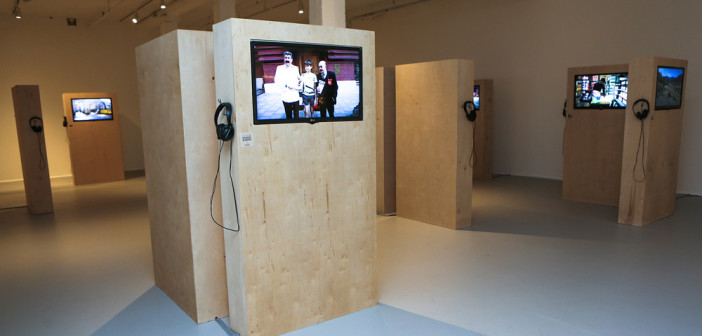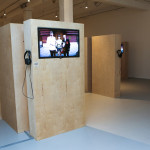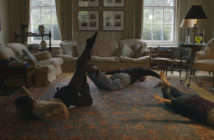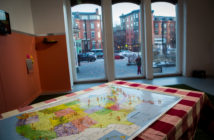Labor in a Single Shot, a collection of documentary videos regarding work, is as straightforward as it sounds. On view this fall at the Mills Gallery at the Boston Center for the Arts, Antje Ehmann and Harun Farocki began curating the project in 2011, hosting workshops in fifteen cities where they dispatched artists to make short, single-shot videos depicting work in any form. All of the films are available online, appearing in a dense grid on the main page and, thankfully, also sorted by city under the "Workshops" tag. It is daunting to decide how to approach the archive, but one of the great strengths of the project is that its constraints and shortcomings have largely been addressed through the use of multiple formats. The Boston exhibition was one of the last in a series of shows in the workshop cities. Seeing the project in a gallery gave the viewer a place to begin, and although it was too much material to process on the spot, it made for a thoughtful starting place when all the work can be easily accessed again later.
The spatial organization at the Mills helped to sort through so much content. Different cities from the project were represented by a loop of videos playing continuously on their own monitors, installed in freestanding wooden pedestals clustered in small groups. Every monitor also had a set of headphones, but a surprising amount of workplaces produce achingly boring sound, and conversations were generally captioned or subtitled in English, so listening felt like an optional level of engagement. Moving through the gallery, it was possible to either focus on a single point of interest or view multiple peripheral screens at a time. Most of the footage is really interesting but not immediately captivating, and even the payoff of a startling or delightful moment does not come frequently enough to make an antsy person want to wait it out every time. The material is obviously not dull, but it is overwhelming to confront what people actually do all day over and over again. I found myself shifting my attention back and forth between two or three screens at once, turning back to another block of monitors beside me or peering through a little alleyway between pedestals. It felt like a typical people-watching experience, a neighborhood condensed from around the world, and in time it became easier to settle into the pace of the show. Sometimes disparate loops would sync up in satisfying ways - the best (and most gruesome) was moving between surgery in a sterile operating room and watching a butcher slice the flesh from a goat’s skull while a shop cat waited for scraps on the counter next to a pile of heads.
Jason Janse van Rensburg, Bead Work, Johannesburg 2014 from Labour in a Single Shot on Vimeo.
The strangest piece came from Lisbon, catching an in-store performance from Popota, an anthropomorphic pink hippo. As far as I can gather Popota is occasionally a cartoon, but more often, she is a person in a mascot costume as seen here. The two-minute video captures the worker in the hippo suit performing dance moves to Lady Gaga’s "Bad Romance," with two women in party dresses carrying the routine. It is mesmerizing in the way that a lot of foreign pop documents are, but in the context of the show the most captivating element is recognizing the way Popota & friends’ labor overlaps with other day jobs. Caught in the video are many other workers beside the performers—members of the event production team, a mid-level manager, and a delighted mall cop all appear in the background near the low stage. Throughout the crowd, parents and other caretakers attend to children. It is tempting to establish a hierarchy or evaluate any one type of worker against another, but it would not matter.
M Goncalves, A. Krabbe, T. van der Maase, Invisible Penal Labour, Lisbon 2013 from Labour in a Single Shot on Vimeo.
A small pamphlet that accompanied the exhibition with one page of questions addressed the similarities and differences across cities, and the way work is informed by larger environmental, social, or political conditions. Ultimately, in trying to digest so much footage, a lot of the framework fades into the background and each video becomes about the very direct relationship between a person, their work, and the artist who is briefly capturing it. Another video from Lisbon seems to describe the project’s success, consisting of a still shot of a weathered wall. This accompanies "the sounds of the street," although most of the audio documents an unseen conversation between the artist and a person who approaches her to find out what exactly she is recording from just outside a prison. Presumably this person is a police officer, and the artist records their interaction, which happens to be a part of his work. Their conversation goes around in circles several times, but over and over she coyly points out that she is outside, not inside, and that she is working as an artist, not a journalist. Ultimately, she is called strange but is not asked to move along. As an artist, she’s afforded a special kind of access to document and an immediate, unstructured part of a person’s day. It is hard to imagine capturing precisely the same qualities in any other type of archive.
- Photo by Melissa Blackall Photography at Mills Gallery, Boston Center for the Arts, Labor in a Single Shot, September 19-November 30, 2014.
The exhibition Labor in a Single Shot was on view at the Mills Gallery at the Boston Center for the Arts from September 19 through November 30.
Image icon: Screengrab from Rui Silveira's Pico Pocata, Lisbon 2011





